
A World of Bioenergy
May 27, 2009
By
Scott Jamieson
You can’t spend more than an hour driving through southern and western Sweden without noticing this country’s dependence on biomass and bioenergy.
You can’t spend more than an hour driving through southern and western Sweden without noticing this country’s dependence on biomass and bioenergy. It’s everywhere, and in part that’s because forestry is everywhere. There’s no hiding the working forest behind roadside buffers here, as cuts go right to the road, loud and proud. And with the cuts come piles of biomass, either neatly piled slash, covered with a special paper wrap and drying to maximize the energy value, or less neatly piled stumps, torn from the ground with a growing array of special attachments, and heaped in a pile to dry and make the separation of dirt and sand easier.
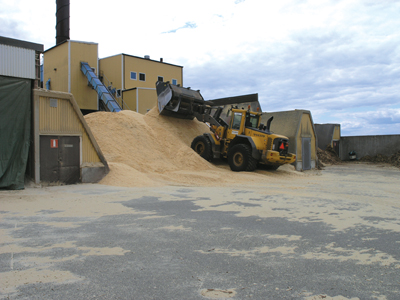 |
|
| The BooForssjo sawmill uses sawdust from its own operation as well as from other mills to feed its pellet mill, which supplies domestic retail markets in both bulk home and bag delivery.
|
It’s a nation of forest biomass. Just the production and market for one product – wood pellets – tells the story. It surprises many people that the US is in fact the world’s largest consumer of wood pellets for small- and medium-scale uses, with an annual consumption of 1.1 million tonnes, according to the Austrian lobby group ProPellets. Yet this growing market still only uses between 3 and 4 kg of pellets per capita per year. In comparison, Sweden uses over 800,000 tonnes per year for large-scale industrial use, and another 800,000 tonnes for small- and medium-scale use, for a total of 1.6 million tonnes per year. That’s a whopping 65 kg of pellets per capita per year for residential heating alone! Some 130,000 tonnes of that comes from Canada, by the way.
According to the Swedish Bioenergy Association (Svebio), over 25% of Sweden’s energy mix comes from biofuels, and much of that forest-based. The nation’s goal is to be independent of fossil fuels by 2020, so look to this relatively small nation to lead the way in the coming decade in both technology and application. Just across the Baltic in Finland the story is similar. Finland’s bioenergy association FinBio reports that bioenergy makes up over 25% of the nation’s energy mix, with wood again playing a key role. So it’s no surprise that the world’s premiere bioenergy event, Elmia World Bioenergy, is held in southern Sweden every two years.
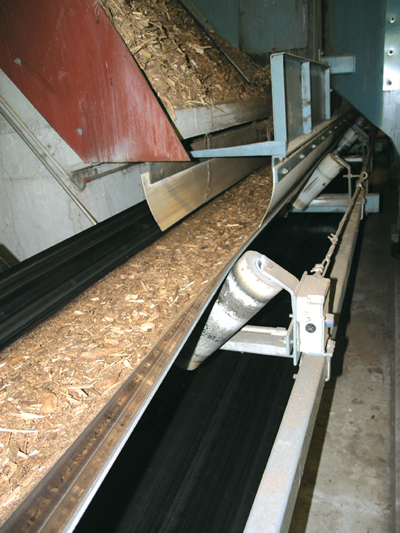 |
|
| The mixed feed at Ena Energi is scraped onto the final infeed conveyor.
|
Opening Tours
Clearly we can learn a lot here as we wind up our own potentially larger biomass industry, and that’s why Canadian Biomass made the trip. So too did many other Canadians, as our forest nation made up the largest foreign delegation at Elmia World Bioenergy 2008. The formal event started Monday night with a reception at the famous Elmia conference facility in Jönköping, an hour south of Stockholm, but it really kicked off sensibly enough with full-day tours from Stockholm’s Arlanda airport to the conference site. We joined a bus that happened to have another 30 or so Canadians, and visited facilities that ranged from combined heat and power plants (CHP) to integrated pellet mills and biomass plantations. With five stops spread over a few hundred kilometres, we pulled into Jönköping a little tired, a little late for the reception, a tad under-dressed, but with a whole new perspective on what’s possible when industry, landowners, local communities, and various levels of government set their mind to it.
The first stop was a shining example. The city of Enköping and its 20,000 inhabitants rely on a single combined heat-power (CHP) plant for 85% of their heating needs. Ena Energi AB is a 100% community-owned company that runs the plant and its three boilers, which have been converted to run on biomass rather than oil or propane. And they must be proud of it – The plant is right in town, not hidden from anyone’s view.
Biomass is a mix of materials, from sawdust (20%) and bark (30%) to pre-hogged forest harvest residues (40%) and material from nearby salix (willow) plantations (10%). Some 6,400 truckloads bring 35 m3 each to the plant annually, and each is sampled for MC. Suppliers are paid by the MWh after MC sampling, providing an incentive to bring well-dried material. The reference rate we were given was 21 Euro ($35) per MWh at the gate. This material is dumped into an infeed pit, where screw conveyors serve to both transport and mix the biomass en route to a large peaked storage building. The biomass is scraped onto a belt conveyor for transport to the boiler, with an MC level that ranges from 20 to 70%.
Aside from 220 GWh of heat per year, it provides 100 MWh of power to the grid, although currently the problem is the imbalance between heat and power needs in summer. To boost year round capacity, the plant is adding a cooling system, as well as a new low-temperature biomass drying system from Exergy Engineering and Consulting that will dry the biomass from its current mix of 47% MC to 30% MC. Both systems will be running this fall.
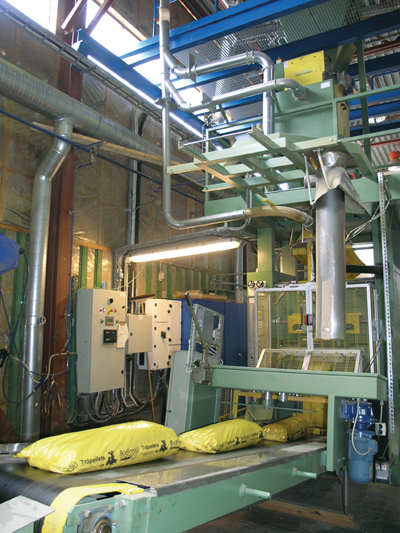 |
|
| BooForssjo’s automated the pellet bagging process in 2001 with this system from Italian supplier Ital Meccanica. It also delivers bulk pellets to homeowners using a heating oil style truck.
|
Our proud hosts were more than willing to tell us costs per MW for different types of delivered biomass, final cost of heat and power to its community clients, delivered to over 1,500 customers (1,180 single homes) via 84 km of pipes. Yet since all such costs are market and distance specific (they hauled in from 100 to 200 km or less), they meant little to the raft of Canadian municipal and forestry delegates on tour with us.
One issue we can all understand is the benefit of fast-growing energy wood close to the power plant. In this case, Ena Energi AB is part of a local fast-growing salix plantation program that kills several birds with one stone. First, it provides an outlet for both 1,500 tonnes of ash the plant makes every year, and an equal amount of sludge from the local sewage treatment plant. It is combined as fertilizer for the salix, greatly reducing the nitrogen and phosphorous load in the local lake, and eventually the Baltic. This fertilizer in turn takes care of another potential issue in the bioenergy cycle – soil nutrient depletion.
Finally, by creating a local salix plantation, the plant has a steady supply of raw material within sight, and one that can be harvested every two to five years. The growth rate of the site we saw, measured in MWh of course, is 20 MWh/ha/yr. It’s a pretty convincing bioenergy cycle, so some 1,200 ha of salix has been planted to date, with 10% of it required to get rid of the ash and sewage mix each year.
The various partners involved since 2001 have each been charged with measuring key indicators, such as heavy metal absorption (ash), nitrogen reduction, and growth rate. So far all indicators point to a rousing success story. Yet like many such stories in Scandinavia’s bioenergy sector, it involves a number of partners co-operating for individual benefit and the common good. In this case, that’s the town’s wastewater treatment authority, the power plant, the local conservation board, town council, and local farmers.
Pellet Power
A business model a little closer to home was BooForssjo, a sawmill and our third stop. In 1995 it added a pellet plant to its facility, an integrated approach where heat from the mill is used to dry both lumber and the pellet raw material. A 15 MW hot gas oven fired with bark and green wood chips makes both hot water (kiln steam) and hot gas (sawdust for pellets, lumber drying). Hot gas and flue gas from the boiler are mixed to create a safe temperature for drying sawdust in a multiple pass rotary dryer. The plant uses Andritz-Sprout Matador pellet mills, and given the fire/explosion risk in handling the dry wood powder, uses one of Firefly AB’s custom-made pellet spark suppression systems. The modestly scaled plant is run on multiple shifts to still produce 53,000 tonnes of pellets per year.
Somewhat different than Canadian mills is the packaging plant. It includes a fully automated Ital Meccanica bagging and palletizing system from Italy for retail sales that was added in 2001, as well as a bulk loading system that is used to fill delivery vehicles. These single and b-train tankers resemble home heating oil delivery trucks seen in Canada, but are able to carry pellets to commercial and residential customers. The BooForssjo-branded delivery truck we saw had a combined tip and hose system to fill homeowner’s bulk pellet hoppers, while another example on site used hose systems. The end result is the same – The same convenience to homeowners as heating oil, without the smell and at lower cost. For the mill, it allows a portion of its production to go right to the retail market.
The fourth stop on our tour was a little far afield for the forest biomass sector, and thankfully so for my taste. The public utility biogas plant in Linköping (140,000 pop.) converts slaughterhouse waste products to biogas as an alternative to propane or diesel in cars and trains. The smell from the plant is indescribable, and while we are no doubt heading this way in Canada, finding sites for such plants will be controversial. Our tour guide admitted that a few neighbours continued to complain about the smell (an understatement), and this after an odour amelioration program. The company runs 12 or so fuelling stations in the town, selling biogas to taxis, buses and private cars, as well as to the locally famous biogas train Amanda.
Our final stop ahead of Elmia was a small community heating plant built in 2007. The community of Odeshog decided to wean itself entirely from fossil fuels, and in 2001 hired Lantmannen, an agricultural co-op and major Swedish player in bioenergy (pellets, heat plants, ethanol) to design, build and run the plant. It uses a 3.5-MW Hotab boiler that can handle a wide range of biomass from 10 to 35% MC. It was running on wood chips while we visited, but the long-term plan is to use more agricultural crops and salix from local farmers. A separate biofuel boiler is available for back-up or heavy loads, and runs on rapeseed oil. The simple plant supplies a 5.3-km grid with 12,500 MWh of heat.
The next Elmia World Bio-energy conference, tour and show is slated for 2010.
Hot Marketing Ideas
Domestic pellet markets will be increasingly important in Canada and the US as a hedge over Europe’s politically primed market, but first we need to develop delivery, storage, and utilization systems that go beyond the Franklin stove model. Both on tour through southern Sweden and at the World Bioenergy trade show, Canadian Biomass saw all the tools for creating and servicing a local home and industrial heating market in a way that requires nothing more from the end user than heating oil does. That’s why half of Sweden’s 1.6 million tonnes of pellets used annually go to home heating, and the average Swede uses 65 kg of pellets for residential heating each year.
There are folks in parts of Canada and the northeastern US, both in the wood products sector and in the heating oil distribution business looking into developing storage, bulk delivery, and automated heating systems for wood pellets, spurred on by escalating oil prices. Many northeastern US home heating distributors have added pellets to their mix of products, although most of these are still in bag form. Smart retailers will start moving further along the bulk heating route. As one Maine entrepreneur said in explaining his pending investment in pellet heating technology, “People don’t buy their oil in a bag – They buy it in bulk. It will have to be the same with pellets.”
There’s no need to reinvent the wheel, although we may adapt existing technology to meet our own needs here over time. As the photos here show, there are lots to pick from already.
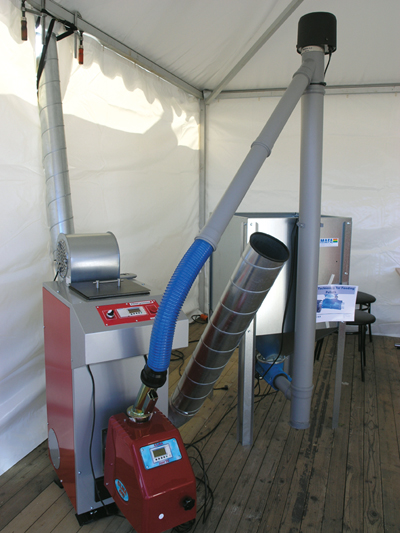 |
|
This simple yet efficient and compact pellet infeed and forced air
furnace system comes from a trio of Scandinavian suppliers co-operating
on the project, and is aimed squarely at the North American retrofit
and new home market. The companies are Matene a.s. of Norway (unique
vertical “fluidizing” feeder), Ulma of Sweden (high-efficiency pellet
burner), and Vanertekno of Sweden (compact hot air furnace). They are
looking for distribution and some licensed manufacturing in North
America. It was shown for the first time ever at World Bioenergy, and
will be shown again at Bioenergy Days late this coming September in
Minnesota. www.matene.com
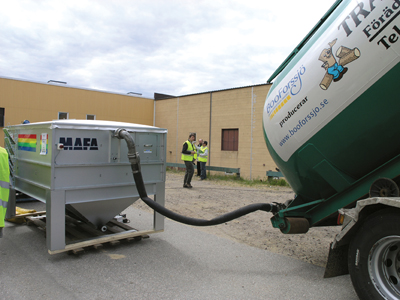 |
|
BooForssjo is a Swedish sawmill that runs its own pellet plant, and then retails pellets directly either in bags filled on an automated system or in bulk from its own fleet of pumper trucks (below). MAFA is a specialized pellet distribution, bulk storage and furnace feed system supplier in Sweden with a half-dozen automated options for pellet-burning home owners depending on space and house layout.
Visit www.mafa.se for an idea of the variety and sophistication.
Print this page